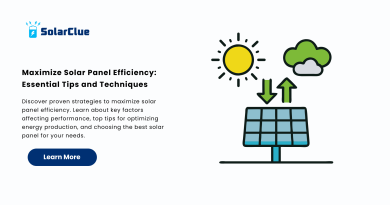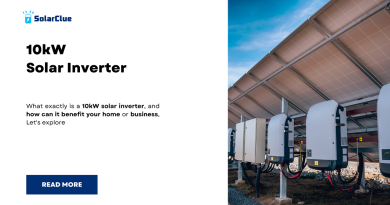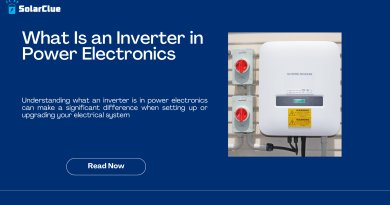What Type Of Current Do Solar Panels Produce?
Solar panels are a key component of the renewable energy revolution, converting sunlight into electricity. But what kind of electricity do they produce, and how is it used in homes and businesses? This guide will explore the type of current generated by solar panels, the photovoltaic effect behind this process, and the role of inverters in making solar power usable. We’ll also compare direct current (DC) and alternating current (AC), explaining their differences and how they work together in solar power systems.
Table of Contents
- 1 The Photovoltaic Effect and How It Generates Electricity
- 2 Direct Current (DC) vs. Alternating Current (AC)
- 3 The Role of Inverters in Solar Power Systems
- 4 The Benefits of Using Solar Panels to Generate DC Electricity
- 5 The Limitations of Using DC Directly in Homes and Businesses
- 6 The Importance of Inverters for Grid Integration
- 7 The Future of Solar Technology and Its Potential Impact on Electricity Production
- 8 Common Misconceptions About the Type of Current Produced by Solar Panels
- 9 Table: Comparison of Direct Current (DC) and Alternating Current (AC)
- 10 Conclusion
- 11 FAQ Section
The Photovoltaic Effect and How It Generates Electricity
The Photovoltaic Effect:
- Definition: The photovoltaic effect is the process by which solar panels convert sunlight directly into electricity. It occurs at the atomic level within the solar cells that make up the panels.
- How It Works:
- Photons and Electrons: When sunlight (photons) hits the solar cells, it excites electrons in the semiconductor material (usually silicon). This excitement causes the electrons to break free from their atoms.
- Electric Field: An electric field within the solar cell drives these free electrons towards the metal contacts, creating a flow of electric current.
Type of Current Produced:
- Direct Current (DC): The electricity generated by solar panels is in the form of direct current (DC), where the electric charge flows in one direction.
Direct Current (DC) vs. Alternating Current (AC)
Direct Current (DC):
- Flow: In DC, electricity flows in a single direction, from the negative side to the positive side of the circuit.
- Usage: DC is commonly used in batteries, solar panels, and small electronic devices.
- Characteristics:
- Voltage: DC voltage is constant over time.
- Power Loss: Less efficient for transmitting electricity over long distances due to power loss.
Alternating Current (AC):
- Flow: In AC, the direction of the electric current reverses periodically, typically 50-60 times per second (Hz).
- Usage: AC is the standard form of electricity used in homes, businesses, and the power grid.
- Characteristics:
- Voltage: AC voltage varies sinusoidally over time.
- Transmission: More efficient for long-distance power transmission due to lower power loss.
The Role of Inverters in Solar Power Systems
Purpose of Inverters:
- DC to AC Conversion: Inverters are crucial components in solar power systems, converting the DC electricity generated by solar panels into AC electricity that can be used by household appliances and fed into the power grid.
- Types of Inverters:
- String Inverters: Convert DC to AC for an entire string of solar panels connected in series.
- Microinverters: Installed on each individual panel, converting DC to AC at the panel level.
- Hybrid Inverters: Combine DC-to-AC conversion with battery storage management.
Grid Integration:
- Synchronization: Inverters synchronize the AC output with the grid’s frequency and voltage, allowing seamless integration of solar power into the existing electrical infrastructure.
The Benefits of Using Solar Panels to Generate DC Electricity
Efficiency:
- Direct Use in Devices: DC electricity is directly usable by certain devices, such as LED lighting, electric vehicles, and battery charging systems, without the need for conversion.
- Energy Storage: DC is ideal for charging batteries, which store energy for later use, making it effective for off-grid applications.
Simplicity:
- System Design: DC-based systems can be simpler in design, especially for small-scale applications like solar-powered gadgets and portable solar generators.
The Limitations of Using DC Directly in Homes and Businesses
Incompatibility with AC Systems:
- Household Appliances: Most household appliances and electrical systems are designed to run on AC, making DC directly from solar panels incompatible without conversion.
- Long-Distance Transmission: DC is less efficient for long-distance power transmission, leading to greater energy losses compared to AC.
Need for Inverters:
- Conversion Requirement: To integrate solar power into the grid or to power AC devices, inverters are necessary to convert DC to AC, adding complexity and cost to the system.
The Importance of Inverters for Grid Integration
Seamless Power Supply:
- Grid-Connected Systems: Inverters enable solar power systems to supply electricity to the grid, ensuring that excess energy produced by solar panels can be sold back to the utility company or used to offset electricity bills.
- Backup Power: In hybrid systems with battery storage, inverters manage the flow of energy between the solar panels, batteries, and grid, providing backup power during outages.
Efficiency Improvements:
- Advanced Inverters: Modern inverters come with features like Maximum Power Point Tracking (MPPT) that optimize the performance of solar panels by adjusting the electrical load to maximize energy harvest.
The Future of Solar Technology and Its Potential Impact on Electricity Production
Emerging Technologies:
- Bifacial Solar Panels: Panels that capture sunlight from both sides, increasing overall energy production.
- Direct DC Grids: Future energy systems may incorporate more direct DC grids, reducing the need for conversion and improving overall efficiency.
Inverter Innovations:
- Smart Inverters: These inverters can interact with the grid to manage power flows, improve stability, and integrate with smart home systems.
Off-Grid Applications:
- Increased Autonomy: Advances in battery storage and DC appliances may lead to more widespread use of off-grid solar systems, especially in remote areas.
Common Misconceptions About the Type of Current Produced by Solar Panels
Misconception 1: Solar Panels Produce AC Electricity:
- Reality: Solar panels produce DC electricity, which needs to be converted to AC by an inverter for use in most homes and businesses.
Misconception 2: DC Electricity is Less Efficient Than AC:
- Reality: DC electricity is more efficient in certain applications, such as battery charging and short-distance power delivery. However, AC is preferred for long-distance transmission.
Table: Comparison of Direct Current (DC) and Alternating Current (AC)
| Feature | Direct Current (DC) | Alternating Current (AC) |
|---|---|---|
| Flow Direction | Unidirectional | Bidirectional (reverses periodically) |
| Voltage | Constant | Varies sinusoidally over time |
| Common Uses | Batteries, solar panels, small electronics | Household appliances, grid power, motors |
| Efficiency | Efficient for short distances | Efficient for long-distance transmission |
| In Solar Systems | Generated by solar panels | Required for grid and household use |
| Need for Inverters | Requires an inverter for AC conversion | No inverter needed for AC systems |
Conclusion
Understanding the type of current produced by solar panels is crucial for anyone interested in solar energy. Solar panels generate direct current (DC) electricity through the photovoltaic effect, but because most homes and businesses use alternating current (AC), inverters are essential for converting DC to AC. This conversion allows solar energy to be seamlessly integrated into the grid, powering everyday appliances and contributing to a more sustainable energy future. As solar technology continues to evolve, innovations in inverters and direct DC systems may further enhance the efficiency and versatility of solar power.
FAQ Section
1. What type of electricity do solar panels produce?
Solar panels produce direct current (DC) electricity.
2. Why do solar panels produce DC instead of AC?
Solar panels produce DC electricity because the photovoltaic effect creates a unidirectional flow of electrons within the solar cells.
3. What is the role of an inverter in a solar power system?
An inverter converts the DC electricity generated by solar panels into alternating current (AC), which is the type of electricity used in homes and businesses.
4. Can I use DC electricity directly in my home?
While some devices can use DC electricity directly, most homes and businesses are wired for AC, so an inverter is typically required.
5. What are the advantages of using DC electricity?
DC electricity is efficient for battery storage and short-distance power delivery, making it ideal for off-grid systems and certain electronic devices.



